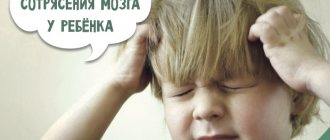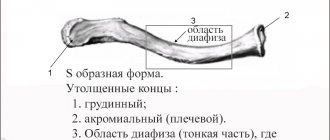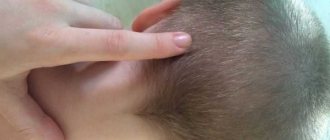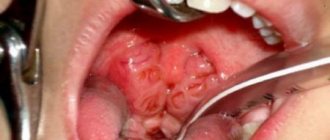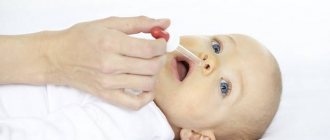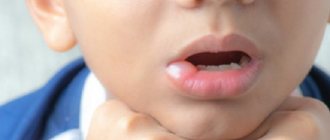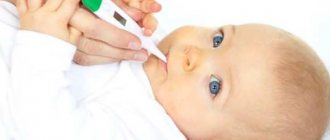If a child hits his nose, the main thing is not to get confused and provide first aid correctly. Usually such bruises are quite harmless and pass without a trace. However, if there is prolonged bleeding (more than 20 minutes), severe headache or deterioration in general condition, you should urgently call an ambulance.
Bruised nose in a preschool boy
Signs of how to identify a bruised nose
What to do if a child hits the back of his head
The main changes in the ENT organ that indicate that a child has bumped his nose include:
- Pain. Localization of pain appears immediately after injury. Unpleasant sensations intensify upon palpation.
- In some cases, damage to the mucous membrane is observed, accompanied by pronounced and prolonged bleeding.
- It's difficult to breathe. The cause is swelling of the mucous membrane.
- The blow provokes vascular damage and hemorrhage under the skin. A hematoma can come from the site of injury under the eyes.
- The edges of the nose are swollen.
Note! If you hit your nose, signs of a bruise appear for two to three days, then the symptoms gradually subside.
Why are head impacts dangerous in young children?
Babies are fidgety - they constantly jump and run, which means they fall. As a result of these “flights,” bumps, bruises, abrasions, etc. appear on the head. Some parents do not pay attention, believing that this is normal and nothing needs to be done. This is their main mistake. If your child hits his head but doesn't complain, you should still see a doctor. Signs of injury may not appear immediately, but may take some time.
Depending on the complexity and nature of the injury, a head injury can provoke:
- epilepsy;
- intracranial hematoma turning into a tumor;
- encephalitis;
- traumatic meningitis.
When a child falls head down, he hits his forehead or fontanelle, resulting in a lump. Small vessels are injured upon impact, and the tissue around them fills with blood. This is how swelling and hematoma form. Thanks to the strong bones of the skull, such injuries do not pose a threat to the baby’s life.
It happens that a newborn or older baby falls on his back. Such a fall can lead to injury to the back of the head. Such bruises often cause serious complications that pose a danger to the baby’s life.
Damage to the back of the head causes:
- loss of consciousness;
- concussions;
- deformation of the skull with subsequent compression of the brain;
- tissue bruise of the main organ of the central nervous system;
- trembling legs.
When children fall, they can injure not only their head, but also their body (dislocate a leg or hit their neck). The possibility of spinal cord injury cannot be ruled out, which can lead to problems with the musculoskeletal system.
Symptoms of a broken nose in a child
What to do if your newborn baby hits his head
Characteristic manifestations of a child’s nose fracture correspond to the type of injury:
- Closed injuries without displacement are manifested by extensive bruising and swelling of the upper facial area. There is visually a depression of the nose; palpation helps determine the exact location of the fracture.
- Open fractures without displacement allow us to infer damage from protruding bone fragments. A bruised nose is often accompanied by wounds of various shapes and sizes.
- Trauma with displacement. Depending on the degree of damage, the child may experience shortness of breath, purulent tissue damage, disturbed water and electrolyte balance, and periodic pain in the trigeminal nerve area.
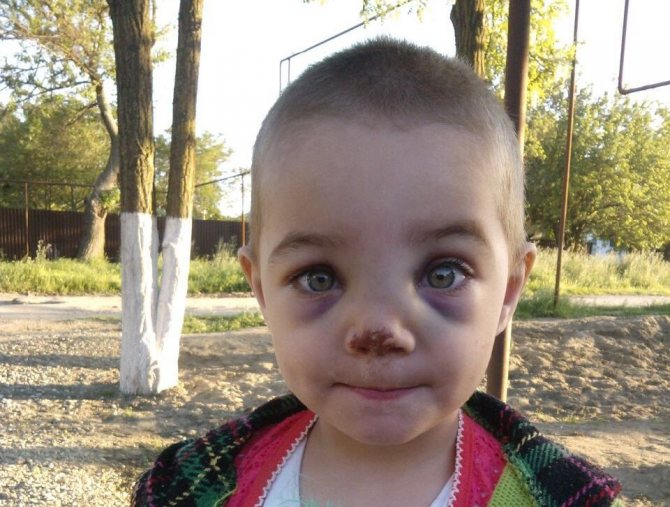
The girl hit her nose on a brick
To accurately determine the location of the injury, the doctor orders an x-ray of the bones of the skull and nose, conducts a visual examination, evaluates the reaction and palpates the area of damage. The totality of symptoms allows you to correctly diagnose and choose treatment tactics. For example, the slow spread of a hematoma, swelling and headache help to understand that the baby could have fractured his skull. The patient requires immediate hospitalization and extensive evaluation of the injury.
Difference from bruise
A bruise is considered to be a closed injury to organs or tissues caused by mechanical force (for example, hitting a table). Damage to the nose is manifested by swelling and bluish skin, increased body temperature, and limited organ functions. The site of the bruise begins to hurt when exposed to external influences.
A fracture is a broken bone. The causes of injury can be mechanical impact, pathological processes occurring in the body. Possible signs of fractures include pain, swelling, hemorrhage, hematomas, and unnatural position of the nasal septum.
Important! Dr. Komarovsky reports: “In most cases, a fracture from a bruise is distinguished by a characteristic crunch when pressed.”
What is a nose contusion?
A bruised nose in a child is one of the most common types of injuries to the facial part of the skull . Despite the fact that soft tissues and shells are damaged, the injury does not imply deformation of cartilage or bones, and the skin often remains intact.
To complete the picture, this article describes the structure of the nose in great detail.
Physical pressure, blows from blunt objects and falls are the three main causes of bruises. Most often this happens to athletes and children. Such injuries often occur due to contact with game equipment or blows from playing partners.
Any sport, especially contact sport, must be accompanied by special equipment that will prevent bruises or other similar troubles.
Definition of bruise
It is almost impossible to determine the presence of a bruise from a photo, much less separate it from a fracture. To do this, you need to pay attention to several symptoms characteristic of a bruise and distinguish them from a fracture:
- nosebleed . The intensity of bleeding may vary depending on the degree of injury;
- swelling in the area of the bruise . In some cases, this swelling can be quite large. If the tumor reaches too large a size, there is a high probability of a fracture, which means you need to urgently contact a traumatologist;
- hematoma (bleeding under the surface of the skin) . Based on the specific location, the bruise can be not only in the immediate area, but also in the eye area. In this case, it would be quite reasonable to contact a specialist;
- painful sensations of varying strength, which often manifests itself after touching the damaged area;
- A bruised nose is most often accompanied by a bruised head.
Definition of fracture
Before you can distinguish a nasal fracture from a bruise, you need to know the possible symptoms of the fracture itself. It’s worth starting with the fact that fractures can occur with or without displacement of bone and cartilage fragments.
Based on this, a specific treatment method will be selected. A non-displaced fracture qualifies as less complex . In fact, it represents solely a crack in the bone. A displaced fracture is more complex. There are two more qualifications:
- Open fracture.
- Closed fracture.
If the fracture is closed, then the integrity of the skin and tissue around the bone is not compromised. With an open fracture, part of the bone or its fragments can often be observed, and in this case, severe blood loss is noted. With a closed fracture, there is a possibility of infection.
With a fracture, several obvious symptoms can be observed, only some of which may be similar to a bruise, so it will be possible to clearly distinguish between the two injuries:
- increased pain in the area of the fracture and the entire nose as a whole, especially during touch. It is worth noting that in the case of contact sports athletes, pain may not be felt immediately due to the rush of adrenaline;
- pronounced change in the shape of the nose. This can happen not only during displacement, but also during swelling;
- swelling in the nose area;
- bleeding. Sometimes the blood flows so strongly and quickly that it is very difficult to stop;
- problems breathing through the nose. This often occurs due to severe swelling;
- severe hematomas, the so-called “symptom of glasses”. Moreover, if there is one, it is very important to seek computed tomography, radiography and ultrasound of the nasal sinuses as quickly as possible. This symptom may indicate a skull injury.
A serious nasal fracture, in the absence of high-quality and timely treatment, can lead to nasal speech. Read this article to get rid of this problem.
First aid for bruises and injuries to the nose
Vomiting in a child - what to do if he spits up heavily like a fountain
If the nose is damaged, it is necessary to learn the specifics of emergency care for open and closed injuries of varying severity.
Injury
If a child breaks his nose when hitting or falling on hard objects, the bruise is accompanied by hemorrhage and hematomas of the septum of the ENT organ. The victim needs rest, a cold compress, and bleeding inhibition. In case of a bruise, an x-ray of the nasal bones is mandatory.
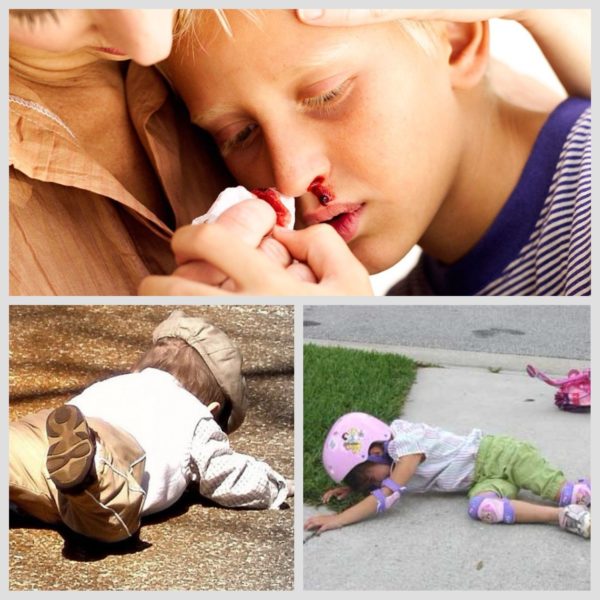
Nosebleeds (epistaxis)
Wound
For minor skin lesions accompanied by bleeding and pain, doctors recommend anointing with a 3% hydrogen peroxide solution and applying a sterile bandage.
If the nose is deeply cut, surgical treatment of the skin and suturing will be required. The procedures are carried out in a clinic or emergency room. The first actions for deep wounds are similar to those for superficial skin damage.
Fracture
The fracture occurs from a blow to the nose in front or from the side. In the first case, both bones are damaged, the back of the ENT organ is bent, in the second, the back of the nose is shifted to the side or pressed in from the side of the impact.
When providing first aid, you should prepare a cold compress, the swelling will go away a little. To combat hemorrhage, it is necessary to fill the nasal canals with cotton swabs (two cm long and 0.5 cm thick) moistened with hydrogen peroxide or naphthyzine 0.1%.
Nasal fracture: diagnosis and treatment
All of the above signs of a bruise are similar to the symptoms of a broken nose. Only with the help of medical hardware diagnostics can a correct diagnosis be established. An urgent visit to a traumatologist will help not only prevent the child’s suffering and restore the normal appearance of the face, but also avoid improper fusion of bones. Nasal asymmetry will require surgical intervention, so self-medication is strictly prohibited. Timely, qualified assistance may help restore the damaged area manually.
The otolaryngologist will perform an external examination, write out a referral for x-rays of the cartilage and bones of the face, and prescribe a procedure to study the inner surface of the nose from different angles (endoscopy). When establishing an accurate diagnosis, consultation with an ophthalmologist and neurologist may be required. You will also need to undergo a series of laboratory tests. An external examination will help establish the nature of the damage, note the degree of hematomas, swelling and curvature of the nasal septum. An x-ray will provide information about possible fractures of bones and cartilage. All of the above data will make it possible to prescribe the correct treatment.
If the diagnosis was made late or medical errors were made during diagnosis and treatment, the injured nose will succumb to asymmetry under the influence of a displacement of the nasal septum. This can ruin the appearance of the face, cause difficulty breathing and a sense of smell. In such a situation, restoration of the cartilage and bone location will be required with the help of plastic surgeons.
To prevent your child from hitting himself, it is extremely important to remove blunt objects from your child’s play area. For these purposes, door handles are tied or closed very tightly so that a fidget cannot open them on their own and get a bruised nose. Older children need to be explained how to communicate correctly with peers in order to avoid fights, during which the face most often suffers. Sports guys who attend judo, boxing, and karate sections need to be instructed on all sorts of safety rules.
Olga Kondratyuk
Further actions
If a child hits his nose slightly and starts bleeding, the doctor will prescribe physical therapy within a few days. The measure helps relieve swelling and pain, normalize blood circulation and stimulate healing processes.
Treatment of fractures is carried out in an ENT hospital. The doctor sets the bone back to its original place, prescribes surgical treatment of the wounds if necessary, and stops the bleeding. Reduction is recommended to be performed within 3-6 days after the impact.
Important! Operations to establish a sunken bone are usually done in two ways: old and new.
Old method of treating a fracture
Under local anesthesia, a long narrow instrument resembling a spatula is used to lift the bone and secure it with a tampon. After one or two days, the gauze is removed.
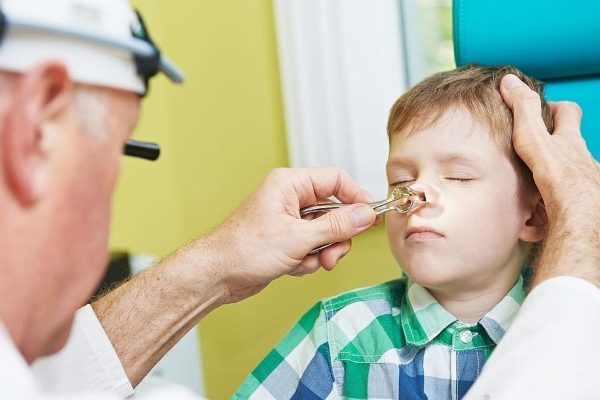
Diagnosis of a fracture
Improved method
Under general anesthesia, the doctor uses a rubberized swab filled with gauze to absorb moisture. The smooth coating of the tampon allows for less bruising of the mucous membrane, and the nose will heal faster. Within a month, a callus forms at the site of the bone retraction, firmly strengthening the bridge of the nose.
Straightening a deviated septum
Deviated septum occurs less frequently than fractures and requires less traumatic surgery. The doctor inserts a thin fiber-optic tube containing a built-in light guide and video camera into the nasal passage. Images are transmitted to the monitor screen. The skin is cut at the entrance to the nostril. The tissues are moved apart, the deformed cartilage is pulled out and straightened, and returned to its original place. The nasal septum is clamped on both sides with silicone plates and sutures are applied. Foreign bodies are removed after a week. The septum remains smooth, the mucous membrane is not allowed to swell, and the nose breathes freely.
Prevention
Of course, it is impossible to protect a child from injuries and blows in advance. Parents should know the rules of first aid and be able to provide it. Timely assistance will alleviate the child’s condition and prevent the development of serious complications.
Injuries to the nose, depending on the intensity of the blow, can be either minor or quite serious, up to a broken nose or concussion. For any injury, it is advisable to consult a specialist, since only he can adequately assess the severity of the damage.
Author: Yulia Khaimanova, doctor, especially for Moylor.ru
Prevention of bruises and other injuries
To prevent bruises, excessive physical activity and injuries should be avoided. When playing sports, it is recommended to use appropriate equipment.
Parents can prevent falls by prohibiting movement in dangerous places. It is important to ensure that there are guardrails on steps, windows and balconies. To avoid open wounds, children should not play in areas containing broken glass, stones, or protruding pieces of metal.
General preventive measures include a nutritious diet enriched with vitamins, micro- and macroelements, regular physical activity (physical education, swimming), wearing comfortable shoes, and parental care.

Prevention of injuries in children
Boys are hospitalized with broken noses twice as often as girls. Children of preschool age are the most active and restless. Older guys are more careful, teenagers have stronger bones. During school years, injuries are the result of fights or poor training. The older the child becomes, the less likely he will fall and injure his nose.
Causes
The most common cause of a bruised nose is a direct blow, which can be received in various ways:
- when colliding with a direct object;
- when falling;
- upon physical contact.
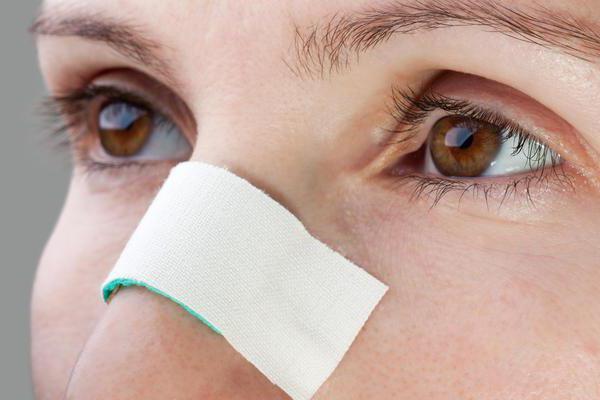
There is a certain risk group that includes people whose activities increase the likelihood of nasal injuries.
- Professional athletes often suffer severe bruises to the nose.
- A bruised nose in a teenage child can occur due to a craving for traumatic sports or during active, aggressive recreation.
- The risk of injuring the bridge of the nose and bruising the nasal soft tissues exists in older people, since various diseases can develop with age, manifested by periodic loss of balance.
- Due to age-related activity, children are at increased risk of nasal injuries.
An increase in injuries is also observed during periods of ice.
Differences between a bruised nose and other injuries
In case of injury to the bridge of the nose and turbinate, it is important to avoid a fracture, which is a deformation of the anatomical structure of the cartilage and bones of the nose.
Indicate:
- violation of the integrity of the skin at the site of impact with the release of bone fragments;
- lateral displacement of the external nose, curvature of the nasal septum, retraction of the nasal dorsum;
- other deformations of the shape of the nose;
- acute pain up to shock;
- complete blocking of the respiratory function of the nose.
The following symptoms indicate a contusion of the olfactory organ:
- painful sensations at the site of the bruise, aggravated by pressing on the tip of the nose;
- swelling of the face as a result of swelling of damaged soft tissues of the nasal cavity;
- nosebleeds of varying degrees of intensity depending on the severity of the injuries;
- subcutaneous hemorrhage, hematoma at the site of the bruise, depending on the force of the blow, the bruise can spread to the infraorbital region of the face, the sclera of the eyes and the eyelid area;
- difficult nasal breathing.
Diagnosis and differentiation of the type of injury are made by a surgeon or traumatologist based on visual examination, palpation and information about the nature of the blow. Anamnesis is collected, since the presence of concomitant diseases of the nasopharynx affects treatment tactics. In some cases, instrumental research methods are required: endoscopy, radiography, ultrasound echography and computed tomography.
Return to contents
First aid rules and treatment
Treatment of nasal bruises, especially in children, should be prescribed and carried out under the supervision of a doctor.
The specialist will differentiate the bruise and rule out a possible concussion, and timely and correctly prescribed treatment will help prevent the development of complications.
First aid for a bruised nose includes the following:
- Applying a cold compress to the injury site. Place an ice pack or a cloth soaked in cold water on the bruised area.
- Stop bleeding from the nasal passages using tight cotton or gauze swabs soaked in hydrogen peroxide or cold water. You can stop the bleeding by pinching the wings of your nose with your fingers and tilting your head forward slightly. This position will help prevent blood from entering the nasopharynx. You should pinch your nose for at least 10 minutes.
- Pain relief with analgesics.
- Transporting the patient to a medical facility.
Treatment of the patient is carried out at home or on an outpatient basis in a clinic at the place of residence and includes:
- applying ice packs during the first 48 hours after injury;
- carrying out thermal procedures starting from the third day of treatment;
- physiotherapy;
- taking vasoconstrictor drops (no more than 3-5 days).
Long-term persistence of edema indicates stagnation of blood in the soft tissues. In this case, the doctor performs a puncture at the site of the tumor and removes the accumulation of blood.
Depending on the severity of the injury, a gentle regimen is recommended for the patient. Children - bed rest for 1 week. It is undesirable to wear glasses until swelling and pain completely disappear. You should avoid physical activity and cancel visits to the sauna or bathhouse.
- What is Nose Trauma?
- What Causes Nose Trauma?
- Symptoms of Nose Trauma
- Diagnosis of Nose Trauma
- Treatment of Nose Trauma


